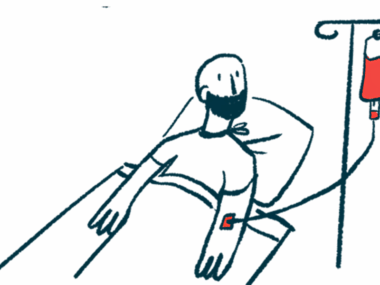Soliris, Ultomiris ‘promising’ as long-term treatments for MG: Report
After 16 years, therapies successfully managed man's hard-to-treat gMG
Written by |

A man with a 16-year history of hard-to-treat generalized myasthenia gravis finally saw his disease successfully managed with Soliris (eculizumab) and then with Ultomiris (ravulizumab) — highlighting the efficacy of these newer treatments for myasthenia gravis (MG) — according to a new case study.
Indeed, its author called these treatments for MG “a breakthrough” for patients, especially those whose disease is refractory, or hard to treat.
“As real-world evidence accumulates, the importance of [such treatments] is becoming increasingly clear, with [Soliris] and [Ultomiris] offering promising long-term management for patients with severe clinical conditions and refractory disease,” the clinician wrote.
The report, “Two-decade battle with myasthenia gravis: A breakthrough case report on the long-term success with eculizumab and ravulizumab treatment,” was published in the journal Clinical Case Reports. The report’s writing was funded by Alexion Pharmaceuticals, the company that markets both Soliris and Ultomiris.
Treatments failed to control man’s MG for over a decade
Myasthenia gravis, known as MG, is an autoimmune disorder that disrupts the communication between nerves and muscles. It is driven by self-reactive antibodies that target proteins crucial for this process, mainly acetylcholine receptors, or AChRs. These proteins are produced by a type of immune cells called B-cells.
Treatments for MG typically involve the use of corticosteroids and immunosuppressants. However, side effects with these medications are common, which may impact treatment adherence.
In recent years, newer treatments — such as Soliris and Ultomiris — have been approved for MG patients who test positive for anti-AChR antibodies. Both of these therapies are administered via intravenous, or into-the-vein, infusions.
Such treatments work by blocking the complement cascade, a part of the immune system that’s believed to contribute to the disease’s damaging immune response. Importantly, Ultomiris is designed to last longer in the body, which allows it to be given less frequently than Soliris.
While data from clinical trials support the effectiveness of these therapies, “confirmation of their long-term effectiveness and safety in routine clinical practice is needed,” according to this report.
Here, Stefan Quasthoff, MD, PhD, from the Medical University of Graz in Austria, described the case of a patient with long-term, hard-to-treat gMG who was successfully treated with Soliris and Ultomiris.
The patient, a 77-year-old man, was diagnosed with AChR-positive gMG in 2004.
He received standard of care treatment with prednisolone, azathioprine, and pyridostigmine (sold as Mestinon), and remained stable for about a year following the start of these therapies.
Eventually, however, he experienced his first myasthenic crisis — a potentially life-threatening event marked by weakness in the muscles that control breathing.
That first crisis was treated with plasma exchange, or plasmapheresis, followed by prednisolone, azathioprine, and pyridostigmine. Plasmapheresis, is a type of treatment used to remove and replace plasma — the liquid portion of blood that contains the self-reactive antibodies that cause MG.
Use of Soliris, Ultomiris also improved man’s quality of life
Crises continued to occur over the next 10 years. They were often made worse by infections (e.g., influenza virus) or stress. Treatment included steroids and immunosuppressants that were administered at variable doses. However, these treatments had minimal success most of the time, with the disease worsening in some instances.
In 2015, and then again in 2017, the man was given treatment with rituximab, but with no clinical improvements. Sold as Rituxan, rituximab is an antibody-based therapy that reduces the number of antibody-producing B-cells. It’s not specifically approved for MG, but is sometimes used off-label in patients with hard-to-treat disease.
In 2017, he developed squamous cell carcinoma, a type of skin cancer, and azathioprine was replaced by another immunosuppressant called mycophenolate mofetil. The cancer was treated with surgery and photochemotherapy, which uses UV rays.
The patient continued to experience recurrent myasthenic crises. In 2019, he started treatment with Soliris, which led to significant improvements, as evidenced by several measures of MG severity and quality of life. However, due to a lack of insurance coverage, he discontinued the therapy for a brief period in April 2020, which caused his MG to worsen. He once again experienced a crisis.
His condition rapidly improved once he resumed treatment with Soliris.
The current case report confirms the long-term effectiveness and safety of [Soliris] and [Ultomiris] as a rescue treatment for gMG in a patient who was unresponsive to conventional immunosuppressive therapies for 16 years.
Two years later, in 2022, he switched to Ultomiris, which was more cost-effective due to its less frequent dosing. The switch occurred without any complications. The patient is now being treated every two months with Ultomiris, and his steroid intake has been reduced.
“The current case report confirms the long-term effectiveness and safety of [Soliris] and [Ultomiris] as a rescue treatment for gMG in a patient who was unresponsive to conventional immunosuppressive therapies for 16 years,” Quasthoff wrote.
For this patient, the clinician wrote, such “treatment was a ‘game changer’ in gMG management.”
Quasthoff cited “not only … [the] rapid improvement [seen] in clinical outcomes but also the fact that these targeted treatments have maintained efficacy over the last 3 years, with a significant positive impact on the patient’s [quality of life].” He added that the man now “is doing well.”








Leave a comment
Fill in the required fields to post. Your email address will not be published.